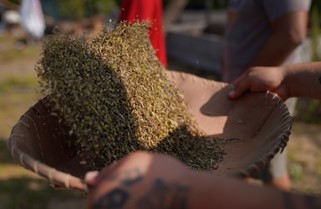
Wild Rice Soup
Ingredients: (makes 8 servings - 2 cups each)
3 C water
1 C wild rice (manoomin)
6 C butternut squash: peeled, seeded, cubed OR 2 1/2 lbs
3/4 C diced onion
3 T olive oil
4 C vegetable broth
1 C milk
2 C home-cooked or canned Great Northern beans, drained and rinsed
1 1/2 tsp salt
1 tsp pepper
Directions:
- Preheat oven to 350 degrees Fahrenheit.
- In a medium saucepan, bring water to a boil. Stir in wild rice and simmer, covered, for 40-45 minutes or just until kernels puff open.
- While rice cooks, put squash on a baking sheet. Stir in 1 T oil and 1 tsp salt. Bake for 15 minutes.
- In a medium saute pan, heat 1 T olive oil over medium heat. Add onions. Stir and cook for 5 minutes or until translucent, but not brown. Remove from heat and set aside.
- When squash is tender, set aside one-half of it. Cook the remaining squash for another 15 minutes or until mashable. Add to a large soup pot and mash.
- To the soup pot, add broth and milk. Bring to a boil and simmer for 5 minutes.
- Uncover rice, fluff with a fork, and simmer an additional 5 minutes, if still wet.
- Add rice and the squash you set aside to the soup pot. Add beans, onions, pepper and ½ tsp salt. Mix and let simmer for another 5 minutes.
- Stir all ingredients together. Taste and adjust for seasoning before serving.
Variations: add sausage, chicken, turkey or mushrooms. Substitute nut milk, carrots for squash.
Note:
Black pepper was brought in by European settlers. It has been added to this recipe to accommodate common tastes. One pound of uncooked wild rice measures about 2 2/3 cups and will yield about 8 to 10 cups cooked. When cooking wild rice, plan on using 3 to 4 cups of liquid for every cup of uncooked rice. Rinse the rice first to remove any debris. 1 cup uncooked wild rice = 3 to 4 cups cooked wild rice. Wild rice can be served hot, warm or cold; for breakfast, in salads, stuffing, breads and more.
Wild rice is a wonderfully balanced food, providing protein and fiber. A serving of wild rice contains fewer calories and double the protein content of brown rice. It contains the micronutrient Manganese, an antioxidant,and plays a role in keeping your cells healthy. Quinoa (another indigenous grain native to South American Incans) is similar to wild rice in terms of nutritional benefits.
Story:
Wild Rice (Manoomin) has been used within American Indian communities, such as the Ojibwe (or Chippewa) and Menominee, for thousands of years. Menomonee in Algonquin means “people of the rice.” It was and continues to be a staple in traditional diets and its harvest is full of gratitude, reverence and ceremony. American Indians continue to nurture the crop, a sacred food. Today’s Ojibwe descend from the Algonquins of what is now the eastern US and SE Canada who faced troubles with European settlers. Legend says they were told go west to find the “food that grows on water.” The discovery of the “good berry” or wild rice was the answer to prayer and sustained their people in a new land.
Wild rice is actually a grass native to North America, mainly in the Great Lakes region. It grows in shallow lakes and streams. When processed by traditional ways, it lasts for many seasons, providing food security. There are now 70 major rice fields around Wisconsin alone.Today, traditional rice fields are challenged by warming waters and contamination by mining and other industrial run-off. The fight to stop oil pipeline 3 near the Bad River Reservation is an attempt to save the manoomin and other species vital to tribal members.
Videos:
Watch a fascinating 33-minute video on the harvest and processing of Manoomin: Dancing the Wild Rice.
A very short PBS video Manoomin: Food that Grows on Water follows Fred Ackley Jr. from the Sokaogon Chippewa Community of Mole Lake as he harvests and processes manoomin, or wild rice which he calls "medicine". He explores the importance of prayer and tradition for cultural survival.
The information above comes from the American Indian Traditional Foods Wisconsin Farm to School Toolkit produced for use in USDA School meals programs by the Wisconsin State Department of Instruction.
The Great Lakes Indian Fish & Wildlife Commission (GLIFWC) has an informative Manoomin-Goodberry brochure about its nutritional value, detailed description of harvesting and how to find tribal retailers for traditional verses “paddy” grown manoomin.
If you would like to be notified when we share new recipes, be sure to scroll to the bottom, provide your email address, check the box confirming you are not a robot, click on a few photos to prove it and click subscribe! You will then receive an email after each new post. Remember, we're always looking for new recipes, so keep sending them to ecopact@fspa.org!





